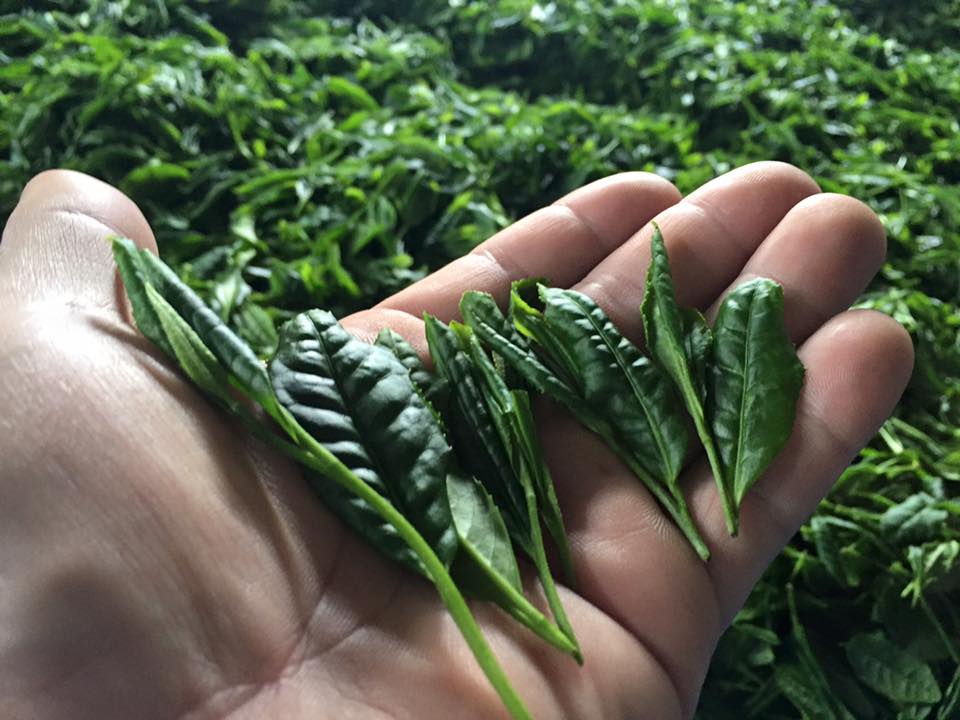日本茶を飲むとき、そのお茶がどんな品種から作られているか考えたことはありますか?「品種」というと、お茶通の世界のイメージが強いかもしれません。しかし、Yunomiではお茶の説明に品種を明記することも多く、またお茶好きの方も単一品種のお茶を求めていることから、今日は日本茶の品種について触れてみても良いのではないかと思いました。
イアン・チュンが以前投稿した栽培品種に関するブログ記事で述べられているように、栽培品種とは栽培された様々な品種のことです。つまり、栽培品種とは、人間が望ましい特性を持たせるために品種改良した植物のグループです。茶の木であるツバキ( Camellia seninsis )の品種改良(日本語:品種改良)は明治時代に始まりました。今日では、未登録の栽培品種を含めると、日本茶の栽培品種は100種類以上あります。
しかし、栽培品種とその改良はお茶の世界だけにとどまらないことをここで触れておくのは重要かもしれません。例えば、リンゴやトマトには様々な品種や栽培品種があります。それぞれ風味や形が異なり、植物自体も見た目が異なり、成長の仕方や成熟時期も異なります。同様にお茶にも、春に生育を始める時期や環境要因に対する感受性が異なる様々な栽培品種があり、それぞれが個性豊かなお茶を生み出します。
数え切れないほど多くの品種から選べる茶葉の中で、茶農家はどのようにして自分の茶園で栽培する茶の品種を選ぶのか疑問に思うかもしれません。これはいくつかの主要な要因によって決まります。ここでは3つの要因について触れたいと思います。
- お茶の種類
- この地域の気候
- 茶畑の面積
お茶の種類
一般的に、日本茶の品種は、 煎茶、 玉露・碾茶、釜炒り茶を作るために栽培されています。どの品種からでもあらゆる種類のお茶(煎茶、ウーロン茶、紅茶など) を作ることができますが、茶農家は作りたい特定のお茶に合った品種を選びます。そのため、煎茶を作るための品種を選ぶ際には、煎茶に加工したときに味と香りが良い品種を検討します。これらの品種は、玉露や碾茶の場合、遮光を考慮する必要があるため、それらと異なる場合があります。そのため、遮光してもよく育ち、さわやかな緑色になる品種が望ましいです。釜炒り茶を作るための品種を選ぶ際には、葉を釜炒りしたときに心地よい香りを放つ品種を検討します。
この地域の気候
お茶は日本各地で栽培されており、南端の鹿児島から関東地方まで、その地域によって気候が異なり、それぞれの気候に適した品種が存在します。例えば、 鹿児島は南部のお茶の主要産地で、温暖な気候で朝霧もあまり発生しません(※ただし、地域の地形にも左右されます)。そのため、鹿児島では、シーズンの早い時期に芽を出す(成長し始める)品種(日本語では、これらの品種は早生種と呼ばれます)が望まれます。実際、鹿児島のいくつかの茶産地は、 ユタカミドリやサエミドリなどの品種を使った走り新茶の産地としてよく知られています。一方、寒冷な地域では、晩霜による被害を避けるために出芽が遅い品種や、 オクミドリ品種(日本語では晩生種と呼ばれる)などの寒さに強い品種が望まれる場合があります。
茶畑の面積
茶農家が広大な土地と複数の茶畑を所有している場合、多くの場合、複数の茶品種を栽培しています。なぜでしょうか?単一の品種に頼ると、収穫時期が全て同時に到来し、収穫だけでなく加工も非常に困難になります。そのため、茶農家では通常、出芽時期の異なる数種類の品種を栽培し、収穫と加工を数週間かけて分散させます(例えば、早生、中生、晩生の品種を組み合わせるなど)。
福岡県八女市にある久万茶園は、単一品種で収穫時期がわずかに異なる多様な茶を生産する茶園の好例です。例えば、「さえみどり」、「やぶきた」、「おくゆたか」という3種類の品種の収穫日は、それぞれ4月14日、20日、30日でした。この茶園は南部に位置しているため、4月という比較的早い時期に収穫が行われます。しかし、収穫時期はそれぞれ数日間ずつずれていることがわかります。
 福岡県八女市久万茶園の山岳煎茶「さえみどり」 。パリ2020年日本茶セレクションで金賞(Prix D'OR)を受賞しました。
福岡県八女市久万茶園の山岳煎茶「さえみどり」 。パリ2020年日本茶セレクションで金賞(Prix D'OR)を受賞しました。
やぶきた品種:なぜ優勢なのか?
栽培品種にあまり詳しくなくても、しばらく日本茶を飲んでいる方なら、「やぶきた」という品種の名前を聞いたことがあるでしょうし、試飲して(願わくば)楽しんだことがあるかもしれません。 1908年に静岡県の農家、杉山彦三郎氏によって開発されたやぶきたは、多くの優れた特性を備えています。この品種は耐霜性があり、様々な地域に適応し、生育も均一で、風味も優れています。杉山氏がこの斬新な農業手法と茶の品種開発を始めたのは、品種改良や、種子からではなく栄養繁殖に関心がほとんどなかった時代だったということを認識することは重要かもしれません。
当時の茶園の大半は種子を使用しており、最も多かったのは後述する在来種/自生種と呼ばれる品種でした。茶は非常に容易に他家受粉するため、1つの植物が別の植物を受粉させることになります。そのため、2つの植物が他家受粉するだけで、わずかに異なる種子がたくさんできます。つまり、当時の主流の茶農家の戦略は、遺伝子に任せるというものでした。その結果、芽吹きの時期も成長速度も風味もわずかに異なる、わずかに異なる様々な茶の木が畑にできました。日本茶の専門家の多くは、日本茶はさまざまな栽培品種(在来)の混合物であることが特徴であり、これらの多様な風味のブレンドこそが有名な日本茶を生み出すのだと強く信じていたため、品種改良に投資することを気にしませんでした。
 2021年の収穫を控えたやぶきた品種の茶畑。写真は梶原茶園提供。
2021年の収穫を控えたやぶきた品種の茶畑。写真は梶原茶園提供。
実は、やぶきたという品種の優れた品質が世間に認められ始めたのは1931年になってからでした。1934年には静岡県農業試験場から高い評価を受け、1953年には農林省に品種登録されました。やぶきたがこれほどまでに普及した理由は、1960年代当時、茶業界には霜を防ぐ技術がまだ確立されていなかったからです。しかし、やぶきたは危険な霜期(5月中旬)を除けば、新芽が均一に芽吹きました。さらに、草勢が強く、栽培しやすく、収穫量も豊富だったため、多くの茶農家に好まれ、安定した栽培品種となりました。
 農林水産省による2020年の統計です。
農林水産省による2020年の統計です。
日本における主要な茶樹の栽培品種を示した上記の円グラフからわかるように、やぶきた品種は2020年でも依然として主要な栽培品種であり、栽培品種全体の70.6%を占めています(農林水産省の報告書) 。 しかし、都道府県別の品種構成を見ると、茶産地の気候やその他の要因によって、地域によって栽培品種が異なることがわかります。例えば、耐寒性に優位性がない温暖な鹿児島県では、他の地域に比べて「やぶきた」の栽培量が少なく、早生種(ゆたかみどりやさえみどり)が比較的多く栽培されています。一方、「やぶきた」が開発された静岡県では、耐寒性と出芽の遅さが大きな強みとなり、「やぶきた」の栽培量が最も多くなっています。
 農林水産省による2020年の統計です。
農林水産省による2020年の統計です。
2016年の全国栽培面積における「やぶきた」の栽培割合は約75%で、過去4年間で5%減少したことになります。今後、全国における「やぶきた」の栽培割合は減少していくと考えられます。これは、茶樹が多年生植物であり、収穫可能な成熟期に達するまでには時間と費用がかかるためです。茶農家では、茶樹の植え替えは通常、樹齢30年を優に超えるまで行われません(植え替える際には、どの品種にするかが重要な判断となります)。「やぶきた」が最も急速に普及したのが1960年代であったことを考えると、現在では茶樹の大半が樹齢40年を超えていると考えられます。農家は、茶樹の老朽化に伴い、植え替え時期や方法を検討しており、今後、茶樹の品種の多様化が進むことが予想されます。
ザイライ、ナチュラルブレンド
1960年代から70年代にかけて栽培品種の開発が盛んになる以前、日本の茶農家は主に種子繁殖で在来茶樹を用いていました。在来(日本語:在来)とは「土着の/固有の」という意味で、識別可能な栽培品種のない古い茶樹を指します。栽培品種は通常、別の茶樹の枝を根付かせて植えることで栄養繁殖するため、実質的にはDNAが一致するクローンとなります。一方、在来は種子から育てられるため、茶樹ごとにわずかに異なる形質を持っています。つまり、在来は厳密には栽培品種ではなく、異なる個体の混合体です。植物学者はそれを個体群と呼ぶこともあります。それでも、一般的には茶樹を総称して在来と呼びます。在来栽培品種の茶畑を注意深く観察する機会があれば、葉の特徴や色が茶樹ごとに異なることに気づくでしょう。茶畑といえば、先日、在来茶畑を訪ねる楽しい夢を見ました。 中国の雲南省は、世界で最も多くの在来茶の木があると言われている地域です(いつか現実にそうなることを願っています!)。
 梶原茶園の在来茶畑。見分けるのは難しいかもしれませんが、よく見ると畑が均一ではないことがわかります。写真は梶原茶園提供。
梶原茶園の在来茶畑。見分けるのは難しいかもしれませんが、よく見ると畑が均一ではないことがわかります。写真は梶原茶園提供。
現在、このタイプの茶栽培は茶農家の間であまり人気がありません。主な理由は、生産性が低い(やぶきた品種に比べて約50%低い)ことと、加工が難しいことです。茶樹は多様であるため、隣り合って植えられた茶樹間で風味や収穫時期が異なり、収穫作業が面倒です。しかし、この多様性は茶樹の回復力を高めます。その多様性と、種子から育てられた茶樹はゴボウのような強く深い根を持つため、より深く浸透したミネラルを吸収でき、干ばつ、害虫、病気に対する耐性が強い傾向があります。また、伝統的な製法を好み、伝統的な日本茶の味にこだわる農家や人々もいます。実際、在来茶は独特の力強さと爽やかな味わいを持っています。古き良き日本の味を味わいたい方は、ぜひ在来茶をお試しください。特に、現在では希少価値が高まっています。
ぜひ試していただきたい在来茶:
- 梶原茶園の伝承:樹齢60年の在来種茶に、奥弥高とやぶきたの茶葉をブレンドした釜炒り茶。
- 喜六茶園の在来種ほうじ茶:喜六茶園は、3人の女性が経営する茶園としてだけでなく、シングルオリジンの茶でも有名です。
べにふうき
近年、日本で注目を集めている品種「べにふうき」は、インド産のアサミカ種と日本茶を掛け合わせた、日本紅茶用の品種として知られています。カテキン含有量が多いため、紅茶にすると風味豊かな褐色へとスムーズに変化します。また、べにふうきは耐病性にも優れ、広く普及している「やぶきた」よりも花や葉が大きく、収量も30%ほど高くなります。紅茶は日本茶生産量のわずか1%を占めるに過ぎませんが、茶農家はべにふうきを使って紅茶以外のお茶作りにも挑戦し始めています。
湯呑みに紅ふうき品種の紅茶をいくつかご紹介します。
- 栗原茶#18:奥八女紅茶 べにふうき
- 大石茶園:対馬柚子紅茶:紅茶に日本の柑橘系の風味を加えたいと思いませんか?大石茶園のこのべにふうき紅茶には、乾燥柚子の皮が入っています!
京都府の品種
ご存知の通り、京都は玉露や抹茶といった遮光が必要なお茶で有名です。五香、さみどり、宇治ひかりの3品種はいずれも京都府で開発されました。これらは正式な品種登録はされていませんが、この地域ではよく栽培されています。抹茶や玉露の濃厚な旨味がお好きなら、ぜひ一度お試しください!
五香:京都府の土壌と気候に合うように特別に育成された品種で、日陰でも育ちやすいことから玉露や抹茶に多く使われています。土を思わせる独特の香りと、豊かな旨味が特徴です。
- 京都和束町の喜六茶園の単一品種「五香抹茶」
- 上島さんの五香玉露:お茶の世界、特に京都府和束町で非常に有名な人物である茶農家の上島さんのクリーミーな五香玉露は期待を裏切りません!
- 東茶園の抹茶品種シリーズ「さみどり」プレミアムセレモニーグレード:鮮やかな色合いと、まろやかさとクリーミーさを兼ね備えた、味わい深い抹茶を求める玄人好みの逸品です。 東茶園では、「さみどり」以外にも、様々な品種をご用意しておりますので、ぜひお試しください。
品種探索
単一品種のお茶をいくつか試されたことがある方、特に気に入ったり、興味を惹かれたりする日本茶の品種はありますか?また、これまで品種について考えたことがなかった方も、このブログ記事が少しでも参考になれば幸いです。個人的な意見ですが、ワインを味わうように、日本茶の多様な味や風味を試してみるのはとても興味深いことです。もし、やぶきたのほっとする味以外にも、もっと色々な味を試してみたいという気持ちがあれば、Yunomiで品種比較も試してみてはいかがでしょうか。同じ生産者、同じ年の異なる品種を飲み比べるのも素晴らしい方法です。楽しいお茶の試飲を!
 品種比較(10g×10種類):あずま茶園 石臼挽き抹茶サンプル。
品種比較(10g×10種類):あずま茶園 石臼挽き抹茶サンプル。
注目の画像:兼六茶園の手摘み「山のいぶき」の新鮮な芽。



